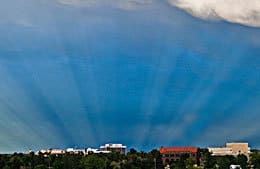Defining Crepuscular Rays – What They Are And How They Form

Occasionally, under specific conditions, different shades of sunlight, or "sunbeams," that penetrate the clouds during sunset create a breathtaking display. This phenomenon is known as Crepuscular Rays.
Crepuscular rays are defined as shades of sunlight that originate below the horizon and shine through cloud edges and gaps into the sky during sunset. It primarily occurs when sunlight travels through broken clouds, but it can also occur when its light is partially obstructed by other objects.
This stunning display of light and color has been witnessed through thousands of generations across the globe and is the subject of countless photographs, paintings, and other forms of art.
Due to its mystical or supernatural appearance, this phenomenon has been adopted and used by different religions and cultures to portray a form of higher power or divine presence. It is no wonder they are commonly referred to as "god rays."
However, these "magical" beams of sunlight are far from supernatural. They are called crepuscular rays and have a scientific and logical explanation.
In this article, we take a close look at what precisely crepuscular rays are, how they form, and what their characteristics are.
What Are Crepuscular Rays?
As just stated, the appearance of these "god rays" has a perfectly logical and scientific explanation. Before taking a more in-depth look at its formation, one first needs to define what precisely crepuscular rays are:
Crepuscular Rays Definition

Crepuscular rays are shades of sunlight from below the horizon shining through openings and edges of clouds into the evening sky during sunset. It primarily occurs when sunlight travels through broken clouds but also happens when the light travels through other objects under the right conditions.
Although crepuscular rays can technically appear throughout the day, the word "crepuscular" originated from the word "crepusculum," which translates to "twilight." As a result, this term is mostly used when rays of light shine up from the horizon during sunset.
(Not to be confused with a sunbeam that shines through a break in the clouds from the sun's elevated position during the day, even though they may be theoretically the same type of occurrence.)
Another reason why crepuscular rays are more noticeable during the late afternoon and early evening is that the beams of sunlight are most visible when there is a strong contrast between light and darkness. These conditions are optimal during sunset.
Although crepuscular rays seem to diverge from the sun and grow larger as they move further away, they actually run parallel to each other and remain the same width.
The reason for this illusion is a result of observers viewing the rays from a perspective point. The same way a long road or railway track seems small at a distance and grows larger, the closer they come, the same way crepuscular rays seem to diverge away from the sun.
The rays that get emitted through the clouds during sunset usually have an orange glow. It occurs as a result of the long path the light has to travel through the atmosphere. Particles in the air scatter blue light, while more yellow and red light is allowed to pass through.
How Crepuscular Rays Form
When the sun is near or just below the horizon, its rays travel up in the darkening sky. When scattered cloud formations are present low in the sky, beams of sunlight travel through the gaps and across the edges of these clouds.

The reason that the rays of light are visible at all is that particles of dust and small droplets are present in the atmosphere, especially closer to the horizon. These particles scatter and refract the light passing through them, making it visible to the naked eye.
As crepuscular rays pass through the clouds, different shades of colors create the appearance of multiple beams of light, which is a result of the density of the medium through which they travel.
Since clouds have different levels of density, they allow different percentages of light through. The clear openings and areas of least density allow rays of light to shine through relatively unaffected, and they appear brighter as a result.
In areas where the cloud cover blocks a larger percentage of light, the rays that are allowed to shine through appear much darker. This combination of light and dark parts of the same light extending into the sky creates the appearance of multiple rays with a spectacular effect.
Anticrepuscular Rays: The Opposite Side Of The Same Phenomenon

At the same time that crepuscular rays occur, a similar phenomenon sometimes appears on the opposite horizon. When you turn your back to the sun, you may see dimmer but similar beams of light converging onto the opposite horizon.
These beams of light are called anticrepuscular rays. They are the same rays of light that originated from the sunset as crepuscular rays.
The bands of light from the crepuscular rays streak right across the sky until they converge toward the vanishing point on the opposite horizon.
Unlike crepuscular rays that diverge away from the sun, anticrepuscular rays converge towards the antisolar point (the position directly opposite that of the sun from the observer's point of view) on the opposite horizon.
Different Names, Similar Phenomenon
As already briefly touched on during the introduction, crepuscular rays have many different names. Some are simply the names different cultures give to the same phenomenon, while others are rooted in religion or history.
The following list of synonyms is just a small sample of the different names given to crepuscular rays:
- God Rays: The name originated from religion, specifically Christianity, where the rays are commonly used to depict a divine presence. The effect and its description are also popular among artists and illustrators.
- Jacob's Ladder: The name is derived from the Old Testament in the Bible, where Jacob had a dream of a staircase extending all the way to Heaven.
- Sun Drawing Water: This synonym is based on an old Greek belief system that the rays of sunlight pull water into the atmosphere.
- Ropes of Maui: This name is based on the tale of the mythical Maui Potiki, who tied ropes to the sun to make the days last longer.
Other names include Buddha rays, light shafts, Tyndall rays, and sunbursts. These are just a few examples, but they give a good indication of just how widespread and significant crepuscular rays are across countries and religions.
Conclusion
As breathtaking and surreal as crepuscular rays may seem to be, this post clearly illustrates how every aspect of their appearance has a perfectly logical and scientific explanation. This should not detract in any way from what is one of nature's most beautiful displays.
This article illustrated what precisely crepuscular rays are, how they form, and what their characteristics are. It also had a look at how widespread and significant this phenomenon is by looking at the various names given to it by different cultures and throughout history.
Never miss out again when another interesting and helpful article is released and stay updated, while also receiving helpful tips & information by simply clicking on this link .
Until next time, keep your eye on the weather!
